 W
WAcanthopholis is a genus of ankylosaurian dinosaur in the family Nodosauridae that lived during the Late Cretaceous Period of England. A single species, A. horrida, exists.
 W
WAcompsoceras is an extinct genus of cephalopod belonging to the Ammonite subclass. It grew to a large size compared to most ammonites. Its shell reached 18 inches (46 cm) in diameter when the animal reached adulthood. Acompsoceras appears in the fossil record during the early portion of the Cretaceous Cenomanian stage and goes extinct around the middle of that same stage.
 W
WAegyptosaurus meaning 'Egypt’s lizard', for the country in which it was discovered is a genus of sauropod dinosaur believed to have lived in what is now Africa, around 95 million years ago, during the Late Cretaceous Period. Like most sauropods, it had a long neck and a small skull. The animal's long tail probably acted as a counterweight to its body mass. Aegyptosaurus was a close relative of Argentinosaurus, a much larger dinosaur found in South America.
 W
WAerodraco is a genus of pterosaur. It contains only one species, Aerodraco sedgwickii. It was originally assigned to the genus Pterodactylus.
 W
WAmtosaurus is a genus of ornithischian dinosaur based on a fragmentary skull collected from the Upper Cretaceous Bayan Shireh Formation of Mongolia and originally believed to represent an ankylosaurid. Hadrosaurid affinities have also been suggested. However, per Parish and Barrett, this specimen is too fragmentary to be reliably classified beyond an indeterminate ornithischian. A second species assigned to the genus, A. archibaldi, has become the basis of a valid ankylosaurid taxon, Bissektipelta.
 W
WAnabisetia is a genus of iguanodont dinosaur from the Late Cretaceous Period of Patagonia, South America. It was a small bipedal herbivore, around 2 metres long.
 W
WAngolasaurus is an extinct genus of mosasaur. Definite remains from this genus have been recovered from the Turonian of Angola, and possibly the Turonian of the United States and Brazil, and the Maastrichtian of Niger. While at one point considered a species of Platecarpus, recent phylogenetic analyses have placed it between the (then) plioplatecarpines Ectenosaurus and Selmasaurus, maintaining a basal position within the plioplatecarpinae.
 W
WAniksosaurus is a genus of dinosaur from what is now Chubut Province, Argentina. It was a theropod, specifically a coelurosaur, which lived in the Cenomanian to Turonian of the Cretaceous period, between 96-91 million years ago. The type species, Aniksosaurus darwini, was formally described from the Bajo Barreal Formation of the Golfo San Jorge Basin by Rubén Dario Martínez and Fernando Emilio Novas in 2006; the name was first coined in 1995 and reported in the literature in 1997. The specific epithet honors Charles Darwin who visited Patagonia in 1832/1833 during the Voyage of the Beagle.
 W
WAnimantarx is a genus of nodosaurid ankylosaurian dinosaur from the Upper Cretaceous of western North America. Like other nodosaurs, it would have been a slow-moving quadrupedal herbivore covered in heavy armor scutes, but without a tail club. The skull measures approximately 25 cm in length, suggesting the animal as a whole was no more than 3 meters long.
 W
WAraripichthys is an extinct genus of prehistoric ray-finned fish that lived from the Aptian to Coniacian stages of the Cretaceous period. The genus is named after the Araripe Basin, where it was found in the Crato and Santana Formations. Other fossils of the genus have been found at Goulmima in Morocco, the Tlayua Formation of Mexico and the Apón Formation of Venezuela.
 W
WArgentinosaurus is a genus of giant sauropod dinosaur that lived during the Late Cretaceous period in what is now Argentina. Although it is only known from fragmentary remains, Argentinosaurus is one of the largest known land animals of all time, if not the largest, with length estimates ranging from 30 to 40 metres and weight estimates from 50 to 100 tonnes. It was a member of Titanosauria, the dominant group of sauropods during the Cretaceous.
 W
WAtlanticopristis is an extinct genus of sclerorhynchid that lived during the Middle Cretaceous (Cenomanian) of what is now the Northeast Region of Brazil, between 100.5 and 93.9 million years ago. Fourteen fossil teeth from Atlanticopristis were found in the Alcântara Formation, and referred to the closely related Onchopristis in 2007; a redescription in 2008 by Portuguese paleontologists Manuel Medeiros and Agostinha Pereira assigned it to a new genus containing one species, Atlanticopristis equatorialis.
 W
WAustralovenator is a genus of megaraptorid theropod dinosaur from Cenomanian -age Winton Formation of Australia. It is known from partial cranial and postcranial remains which were described in 2009 by Scott Hocknull and colleagues, although additional descriptions and analyses continue to be published. It is the most complete predatory dinosaur discovered in Australia.
 W
WAxelrodichthys is an extinct genus of mawsoniid coelacanth from the Cretaceous of Africa, North and South America, and Europe. Several species are known, the remains of which were discovered in the Lower Cretaceous (Aptian-Albian) of Brazil, North Africa, and possibly Mexico, as well as in the Upper Cretaceous of Morocco (Cenomanian), Madagascar and France. The French specimens are the last known representatives of the Mawsoniidae and the youngest of the extinct coelacanths along with the genus Megalocoelacanthus from North America. The Axelrodichthys of the Lower Cretaceous frequented both brackish and coastal marine waters while the most recent species lived exclusively in fresh waters. Most of the species of this genus reached 1 metre to 2 metres in length. Axelrodichthys was named in 1986 by John G. Maisey in honor of the American ichthyologist Herbert R. Axelrod.
 W
WBahariasaurus is a genus of theropod dinosaur found in the Bahariya Formation in El-Waha el-Bahariya or Bahariya oasis in Egypt, and the Farak Formation of Niger of North Africa, which date to the late Cretaceous Period,, about 95 million years ago. It was a huge theropod, in the same size range as Tyrannosaurus and the contemporary genus Carcharodontosaurus. It was about 11-12 meters in length and 4 tonnes in weight.
 W
WBeg is a genus of neoceratopsian dinosaur from the early Cretaceous Period of Mongolia. The genus contains a single species, Beg tse, known from a partial skull and very fragmentary postcrania. Beg represents the most basal neoceratopsian currently known.
 W
WBurmese amber, also known as Burmite or Kachin amber, is amber from the Hukawng Valley in northern Myanmar. The amber is dated to around 99 million years old, during the earliest part of the Cenomanian age of the Late Cretaceous. The amber is of significant palaeontological interest due to the diversity of flora and fauna contained as inclusions, particularly arthropods including insects and arachnids but also birds, lizards, snakes, frogs and fragmentary dinosaur remains. The amber has been known and commercially exploited since the first century AD, and has been known to science since the mid-nineteenth century. Research on the deposit has attracted controversy due to its alleged role in funding internal conflict in Myanmar and hazardous working conditions in the mines where it is collected.
 W
WCalycoceras is an extinct genus of cephalopods belonging to the subclass Ammonoidea and family Acanthoceratidae that lived during the Cenomanian stage of the Late Cretaceous, 100-94 Mya. Their shells had ornate ribs.
 W
WCathartesaura is a genus of rebbachisaurid sauropod dinosaur hailing from the Late Cretaceous strata of the Huincul Formation, at the "La Buitrera" locality, in the Neuquén Basin of Río Negro Province, Argentina. The fossil remains, described by Gallina and Apesteguía in 2005, consist of a partial skeleton including vertebrae and limb bones. These were found at the base of the formation, which spans the Cenomanian and Coniacian epochs, in mudstone and sandstone levels.
 W
WCimoliopterus is a genus of pterodactyloid pterosaur from the Cretaceous of England, United Kingdom and Texas, United States.
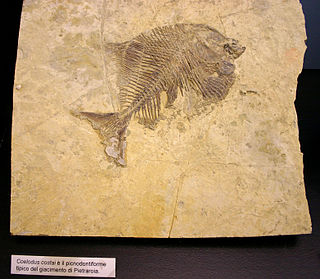 W
WCoelodus is an extinct genus of pycnodontiform fish from the Late Jurassic to early Paleocene (Danian). Fossils of the genus have been found in:JurassicGardies, FranceCretaceousYacoraite Formation, Argentina El Molino Formation, Bolivia Baharîje Formation, Egypt Ahlen and Bückeberg Formations, Germany Nimar Formation, India Alburni, Italy Damergou, Zinder, Niger Cochirleni Formation, Romania La Huérguina and Cabana Formations, Spain Pierre Shale, Kansas Tunbridge Wells Sand Formation, England Tucumcari Formation, New Mexico Twin Mountains and Paluxy Formations, TexasPaleoceneTremp Formation, Spain
 W
WCronopio is an extinct genus of dryolestoid mammals known from the Río Negro region of Argentina.
 W
WDeltadromeus is a genus of theropod dinosaur from Northern Africa. It had long, unusually slender hind limbs for its size, suggesting that it was a swift runner. The skull is not known. One fossil specimen of a single species has been described, found in the Kem Kem Beds, which date to the mid Cretaceous Period, about 95 million years ago. It may be a junior synonym of the contemporary Bahariasaurus. Deltadromeus has often been considered a ceratosaurian, more specifically a member of the family Noasauridae. In 2016, a South American theropod known as Gualicho shinyae was found to possess many similarities with Deltadromeus. Depending on the phylogenetic position of Gualicho, Deltadromeus may have been a neovenatorid carnosaur, a tyrannosauroid, or a basal coelurosaur if its close relation to Gualicho is legitimate.
 W
WDendroolithus is an oogenus of Dendroolithid dinosaur egg found in the late Cenomanian Chichengshan Formation, in the Gong-An-Zhai and Santonian Majiacun Formations of China and the Maastrichtian Nemegt and Campanian Barun Goyot Formation of Mongolia. They can be up to 162 mm long and 130 mm wide. These eggs may have been laid by a Therizinosaur, Sauropod, or Ornithopod. The oospecies "D." shangtangensis was originally classified as Dendroolithus, however, it has since been moved to its own distinct oogenus, Similifaveoloolithus. This oogenus is related with embryos of the theropod Torvosaurus
 W
WDiamantinasaurus is a genus of titanosaurian sauropod from Australia that lived during the early Late Cretaceous, about 94 million years ago. The type species of the genus is D. matildae, first described and named in 2009 by Scott Hocknull and colleagues based on fossil finds in the Winton Formation. Meaning "Diamantina lizard", the name is derived from the location of the nearby Diamantina River and the Greek word sauros, "lizard". The specific epithet is from the Australian song Waltzing Matilda, also the locality of the holotype and paratype. The known skeleton includes most of the forelimb, shoulder girdle, pelvis, hindlimb and ribs of the holotype, and one shoulder bone, a radius and some vertebrae of the paratype.
 W
WEkrixinatosaurus is a genus of abelisaurid theropod which lived approximately 100 to 97 million years ago during the Late Cretaceous period. Its fossils have been found in Argentina. Only one species is currently recognized, Ekrixinatosaurus novasi, from which the specific name honors of Dr. Fernando Novas for his contributions to the study of abelisaurid theropods.
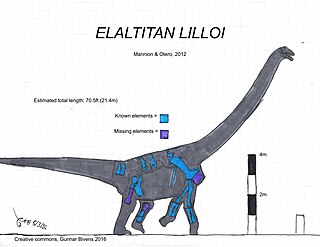 W
WElaltitan is an extinct genus of large lithostrotian titanosaur sauropod dinosaur known from the Late Cretaceous of Chubut Province, southern Argentina. It contains a single species, Elaltitan lilloi.
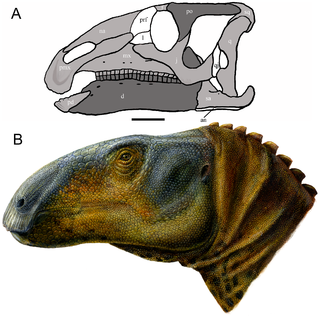 W
WEolambia is a genus of herbivorous hadrosauroid dinosaur from the early Late Cretaceous of the United States. It contains a single species, E. caroljonesa, named by paleontologist James Kirkland in 1998. The type specimen of Eolambia was discovered by Carole and Ramal Jones in 1993; the species name honors Carole. Since then, hundreds of bones have been discovered from both adults and juveniles, representing nearly every element of the skeleton. All of the specimens have thus far been found in Emery County, Utah, in a layer of rock known as the Mussentuchit Member of the Cedar Mountain Formation.
 W
WGarudimimus is a genus of ornithomimosaur that lived in Asia during the Late Cretaceous. The genus is known from a single specimen found in 1981 by a Soviet-Mongolian expedition in the Bayan Shireh Formation and formally described in the same year by Rinchen Barsbold; the only species is Garudimimus brevipes. Several interpretations about the anatomical traits of Garudimimus were made in posterior examinations of the specimen, but most of them were criticized during its comprehensive redescription in 2005. Extensive undescribed ornithomimosaur remains at the type locality of Garudimimus may represent additional specimens of the genus.
 W
WGiganotosaurus is a genus of theropod dinosaur that lived in what is now Argentina, during the early Cenomanian age of the Late Cretaceous period, approximately 98 to 97 million years ago. The holotype specimen was discovered in the Candeleros Formation of Patagonia in 1993, and is almost 70% complete. The animal was named Giganotosaurus carolinii in 1995; the genus name translates as "giant southern lizard" and the specific name honors the discoverer, Rubén D. Carolini. A dentary bone, a tooth and some tracks, discovered before the holotype, were later assigned to this animal. The genus attracted much interest and became part of a scientific debate about the maximum sizes of theropod dinosaurs.
 W
WGilmoreosaurus is the name given to a genus of dinosaur from the Cretaceous of Asia. The type species is Gilmoreosaurus mongoliensis. It is believed to be a hadrosaur or iguanodont from the Iren Dabasu Formation of Inner Mongolia, dating to 96 Ma ago. Additional specimens have been described as distinct species, including G. atavus from the Khodzhakul Formation of Uzbekistan and G. arkhangelskyi from the Bissekty Formation. However, these are based on very fragmentary remains, and their classification is dubious. An additional species, G. kysylkumense is sometimes included, though it has also been referred to the related genus Bactrosaurus.
 W
WGinglymostoma is a genus of shark in the family Ginglymostomatidae. This fish lives in Brazil, the United States, Colombia, Ecuador, Cape Verde, Morocco, Mauritania, Senegal, the Gambia, Guinea-Bissau, Guinea, Sierra Leone, Liberia, Ivory Coast, Ghana, Togo, Benin, Nigeria, Cameroon, Equatorial Guinea, Republic of the Congo, Angola, the Democratic Republic of the Congo, Gabon, France, Spain, Nicaragua, Saint Lucia, Guatemala, Saint Vincent and the Grenadines, Guyana, Grenada, Suriname, French Guiana, Trinidad and Tobago, Dominica, Martinique, Dominican Republic, Costa Rica, Honduras, Haiti, Jamaica, Puerto Rico, El Salvador, Saint Kitts and Nevis, Turks and Caicos Islands, Guadeloupe, Montserrat, Antigua and Barbuda, Belize, Anguilla, Virgin Islands, Venezuela, Saint Martin, Sint Eustatius, Bonaire, Barbados, Bermuda, Aruba, Mexico, Cayman Islands, and Peru. There are two members in the genus. Members of this genus eat small fish and crustaceans, and are commonly quite lethargic unless provoked. Members of this genus have the ability to suck in water in order to remove snails from their shells in a manner that can be described as 'vacuum-like'.
 W
WIlokelesia is an extinct genus of abelisaurid theropod, preserved in the layers of the earliest Late Cretaceous of the Huincul Formation, Neuquén Group, located near Plaza Huincul, Neuquén Province, Argentina. The specimen, consisting of very fragmentary elements of the skull and the axial and appendicular skeleton, was described by Rodolfo Coria and Leonardo Salgado in late 1998.
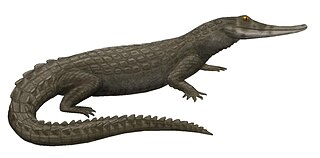 W
WIsisfordia is an extinct genus of crocodyliform closely related to crocodilians that lived in Australia during the Middle Cretaceous (Albian–Cenomanian).
 W
WKaikaifilusaurus is an extinct genus of rhynchocephalians in the family Sphenodontidae from the Late Cretaceous of South America. Fossils of the genus were found in Cenomanian sediments of the Candeleros Formation and Turonian layers of the Huincul Formation, both of the Neuquén Basin and the Albian strata of the Cerro Barcino Formation in the Cañadón Asfalto Basin, all in Patagonia, Argentina. The genus contains two species, K. minimus and the type species K. calvoi.
 W
WKatepensaurus is an extinct genus of rebbachisaurid sauropod dinosaur known from the Late Cretaceous of south-central Chubut Province of central Patagonia, Argentina. It contains a single species, Katepensaurus goicoecheai.
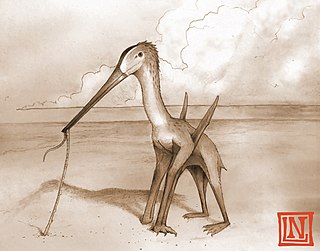 W
WLeptostomia is a genus of long-beaked pterosaur from the mid-Cretaceous (?Albian-Cenomanian) of Morocco, North Africa. The type species is L. begaaensis, which was named and described in 2020 from sediments of the Kem Kem Group in Morocco. It was a small animal with a long, slender bill which is thought to have been used to probe sediments for worms and other invertebrates, similar to kiwi birds and curlews. Leptostomia is likely a member of the Azhdarchoidea.
 W
WLimaysaurus is a genus represented by a single species of rebbachisaurid sauropod dinosaurs, which lived during the mid-Cretaceous period, about 99.6 to 97 million years ago, in the Cenomanian, in what is now South America.
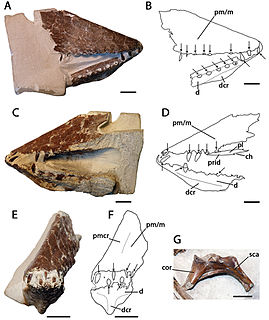 W
WLonchodraco is a genus of lonchodectid pterodactyloid pterosaur from the Late Cretaceous of southern England. The genus includes species that were previously assigned to other genera.
 W
WMacroscaphites is an extinct cephalopod genus included in the Ammonoidea that lived during the Barremian and Aptian stages of the Early Cretaceous. Its fossils have been found throughout most of Europe and North Africa.
 W
WMapusaurus was a giant carcharodontosaurid carnosaurian dinosaur from the early Late Cretaceous of what is now Argentina and possibly Chile.
 W
WMawsonia is an extinct genus of prehistoric coelacanth fish, and the largest of this group, ranging from an estimated 3.5 metres up to 6.3 metres long. It lived during the Cretaceous period. Fossils have been found in the Bahia Group, Romualdo, Alcântara and Missão Velha Formations of Brazil, South America, as well as the Continental Intercalaire of Algeria and Tunisia, the Ain el Guettar Formation of Tunisia, and the Babouri Figuil Basin of Cameroon, Africa. Mawsonia was first described by British palaeontology Arthur Smith Woodward in 1907. The type species is Mawsonia gigas, named and described in 1907. Numerous distinct species have been described since then. M. brasiliensis, M. libyca, M. minor, and M. ubangiensis have all been proposed to be synonyms of M. gigas, although Léo Fragoso's 2014 thesis on mawsoniids finds M. brasiliensis valid and cautions against synonymizing M. minor without further examination. Several recent publications consider M. brasiliensis to be valid as well. Although initially considered to belong to this genus, "Mawsonia" lavocati is most likely referable to Axelrodichthys instead.
 W
WMetoioceras is an extinct genus of cephalopod belonging to the Ammonite subclass which lived during the Cenomanian.
 W
WNicorhynchus is a genus of pterosaur. It contains two species, the type species N. capito from of the Cambridge Greensand of England, and N. fluviferox from the Kem Kem Group of Morocco. These species were previously assigned to Coloborhynchus.
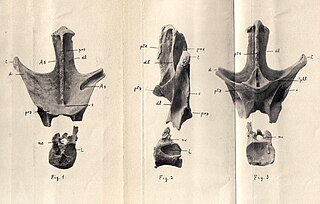 W
WNopcsaspondylus is a genus of rebbachisaurid sauropod dinosaur from the Cenomanian-age Candeleros Formation of Neuquén, Argentina. It is based on a now-lost back vertebra described by Nopcsa in 1902 but not named at the time. The specimen had a small vertebral body and large hollows, now known to be typical of rebbachisaurids.
 W
WOxalaia is a genus of spinosaurid dinosaur that lived in what is now the Northeast Region of Brazil during the Cenomanian stage of the Late Cretaceous period, sometime between 100.5 and 93.9 million years ago. Its only known fossils were found in 1999 on Cajual Island in the rocks of the Alcântara Formation, which is known for its abundance of fragmentary, isolated fossil specimens. The remains of Oxalaia were described in 2011 by Brazilian palaeontologist Alexander Kellner and colleagues, who assigned the specimens to a new genus containing one species, Oxalaia quilombensis. The species name refers to the Brazilian quilombo settlements. Oxalaia quilombensis is the eighth officially named theropod species from Brazil and the largest carnivorous dinosaur discovered there. It is closely related to the African genus Spinosaurus, and/or may be a junior synonym of this taxon.
 W
WRebbachisaurus is a genus of sauropod dinosaur of the superfamily Diplodocoidea, that lived during the Late Cretaceous period in Africa about 99-97 million years ago. Remains attributed to Rebbachisaurus have been found in Morocco, Niger, Algeria and Tunisia, although only the Moroccan remains can be referred to the genus without doubt. The discovery of Rayososaurus, a South American sauropod nearly identical to Rebbachisaurus, supports the theory that there was still a land connection between Africa and South America during the Early Cretaceous, long after it was commonly thought the two continents had separated.
 W
WRugops is a genus of abelisaurid theropod dinosaur that inhabited what is now Africa approximately 95 million years ago, during the Cenomanian stage of the Late Cretaceous.
 W
WSauroniops is a genus of carnivorous basal carcharodontosaurid theropod dinosaur known from the Late Cretaceous of Morocco.
 W
WSegnosaurus is a genus of therizinosaurid dinosaur that lived in what is now southeastern Mongolia during the Late Cretaceous, about 102–86 million years ago. Multiple incomplete but well-preserved specimens were discovered in the Gobi Desert in the 1970s, and in 1979 the genus and species Segnosaurus galbinensis were named. The generic name Segnosaurus means "slow lizard" and the specific name galbinensis refers to the Galbin region. The known material of this dinosaur includes the lower jaw, neck and tail vertebrae, the pelvis, shoulder girdle, and limb bones. Parts of the specimens have gone missing or become damaged since they were collected.
 W
WSigilmassasaurus is a genus of spinosaurid dinosaur that lived approximately 100 to 94 million years ago during the middle of the Cretaceous Period in what is now northern Africa. Named in 1996 by Canadian paleontologist Dale Russell, it contains a single species, Sigilmassasaurus brevicollis. The identity of the genus has been debated by scientists, with some considering its fossils to represent material from the closely related species Spinosaurus aegyptiacus, while others have classified it as a separate taxon, forming the clade Spinosaurini with Spinosaurus as its sister taxon.
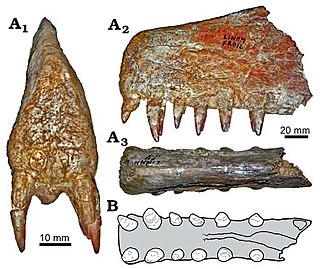 W
WSiroccopteryx is an extinct genus of pterodactyloid pterosaur, known from the middle Cretaceous sediments in Morocco. Some researchers, such as David M. Unwin, consider the genus a junior synonym of Coloborhynchus.
 W
WSkorpiovenator is a genus of abelisaurid theropod dinosaur from the Late Cretaceous Huincul Formation of Argentina. It is one of the most complete and informative abelisaurids yet known, described from a nearly complete and articulated skeleton.
 W
WTalenkauen is a genus of basal iguanodont dinosaur from the Campanian age. Late Cretaceous Cerro Fortaleza Formation, formerly known as the Pari Aike Formation of Patagonian Lake Viedma in the Austral Basin of Santa Cruz, Argentina. It is based on MPM-10001, a partial articulated skeleton missing the rear part of the skull, the tail, and the hands. Its most unusual feature is the presence of several thin mineralized plates along the sides of the ribs.
 W
WTurrilites (Turrilites) costatus is a species of helically coiled ammonoid cephalopod, from the lower part of the Upper Cretaceous (Cenomanian).
 W
WVascoceras is an extinct genus of Cretaceous ammonites included in the family Vascoceratidae. These fast-moving nektonic carnivores lived in the Cretaceous period from the late Cenomanian to the early Turonian. The type species of the genus is Vascoceras gamai from Portugal.
 W
WVeridagon avendanoi is an extinct aulopiform ray-finned fish related to species of Enchodus from the Cenomanian-aged Cintalapa Formation, exposed in El Chango Quarry, Chiapas, Mexico. Its original generic name was Dagon; however, this name was preoccupied by a group of South American butterflies. The generic name was eventually amended to Veridagon.
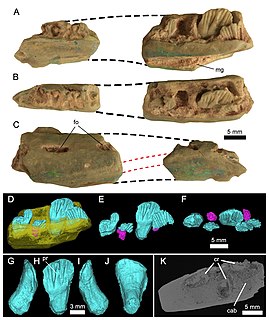 W
WWeewarrasaurus is a genus of ornithopod dinosaur from the Late Cretaceous of the Griman Creek Formation near Lightning Ridge, in New South Wales, Australia. The type and only species is W. pobeni, known from the holotype, an isolated dentary preserved in opal, as well as a secondary referred dentary. It is thought to have co-existed with multiple other ornithopods of different sizes and lineages.
 W
WYaksha perettii is an extinct species of Albanerpetontid amphibian, and the only species in the genus Yaksha. It is known from three specimens found in Cenomanian aged Burmese amber from Myanmar. The remains of Yaksha perettii are the best preserved of all albanerpetontids, which usually consist of isolated fragments or crushed flat, and have provided significant insights in the morphology and lifestyle of the group.